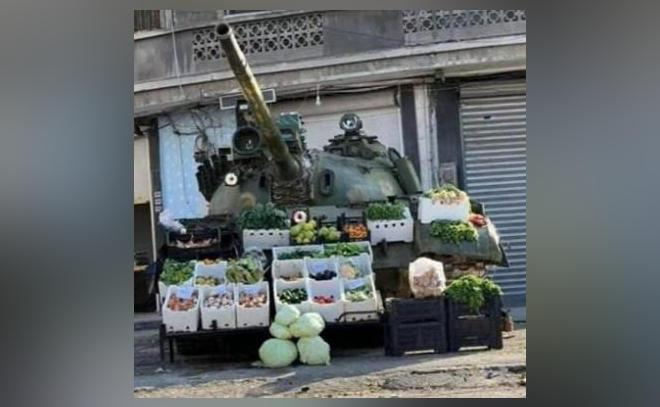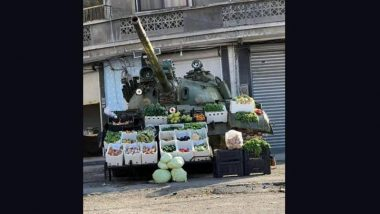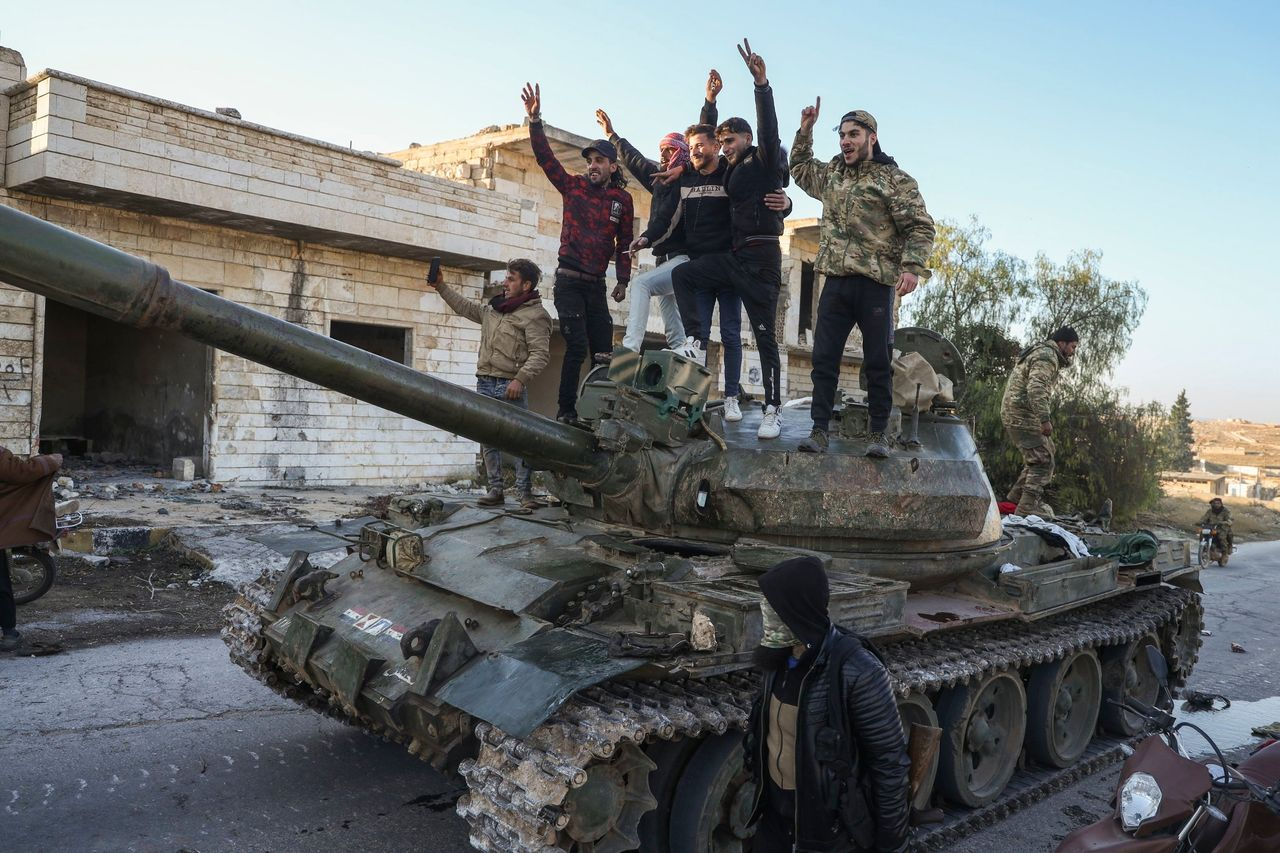Once a symbol of power and control during the Syrian Civil War, the T-55 tank, which served under the Bashar al-Assad regime, now stands as a relic of conflict turned into a makeshift vegetable stand in Damascus.
This unusual sight reflects the profound transformation Syria has undergone following the collapse of Assad’s rule. While the war-torn nation slowly recovers, remnants of abandoned military machinery have found new and often surreal purposes in the post-war landscape.
The fall of Damascus, once deemed impenetrable, and the subsequent exile of Bashar al-Assad marked the end of decades-long rule and ushered in an uncertain chapter for the country.
The Transformation of Damascus and Its Abandoned Symbols of War
The city of Damascus, the capital of Syria and one of the world’s oldest continuously inhabited cities, has witnessed unimaginable destruction and turmoil over the past decade.
However, it was the events of December 8, when the Islamist Hayat Tahrir al-Sham (HTS) and rebel forces breached the capital’s defenses, that ultimately sealed the fate of the Assad regime. In the aftermath of the swift offensive, Assad’s once formidable military abandoned tanks, weapons, and infrastructure as the city fell into chaos.
Among the abandoned military relics was the Soviet-era T-55 tank, a vehicle that had served Assad’s forces since the early years of the war. Once used to patrol cities and suppress uprisings, the T-55 tank has now found a bizarre yet practical role in post-Assad Syria: as a vegetable stand.
Read : 7,600 Syrians Head Home After Bashar al-Assad’s Fall
Images of the tank, stripped of its military features and repurposed to hold crates of tomatoes, cucumbers, and potatoes, have captured global attention. This transformation symbolizes more than just ingenuity in times of hardship — it reflects a stark contrast between the city’s past and present realities.
Read : Syria Resumes Saudi Flights After 12 Years of Suspension
The T-55’s presence as a vegetable stand reveals the resilience and adaptability of the Syrian people, who continue to rebuild their lives amidst ruins.
Vendors in Damascus, faced with limited resources and economic devastation, have turned to unconventional means to sustain their businesses. The tank, once a harbinger of war, now serves a peaceful and communal purpose, albeit an ironic one.
Bashar al-Assad’s Final Hours in Syria
The events leading up to Assad’s departure from Syria were both swift and unexpected. For decades, Bashar al-Assad and his family had ruled Syria with an iron fist, surviving uprisings, sanctions, and military confrontations. However, the rebel offensive led by Hayat Tahrir al-Sham (HTS) proved decisive.
On December 7, the Islamist forces infiltrated Damascus, overwhelming Assad’s weakened military and forcing them to abandon strategic positions. By December 8, the regime’s defenses had crumbled, and Assad himself was forced to flee.

Assad’s statement, issued a week later from Russia, paints a picture of his final hours in Syria. He insisted that his departure was not premeditated and that he remained in Damascus until the early stages of the city’s fall.
With rebels closing in, Assad retreated to Latakia, where Russia maintains its naval base. His Russian allies facilitated his evacuation from the Hmeimim airbase, marking the end of his regime.
Assad’s account reflects his continued defiance, as he referred to the rebels as “terrorists” and claimed to have overseen military operations until the last moment.
However, reports suggest that Assad’s departure was hurried and secretive, with even his closest aides unaware of his plans. The collapse of Damascus, once considered Assad’s stronghold, marked not only the military defeat of the regime but also the symbolic end of the Assad family’s grip on power.

Russia’s role in Assad’s escape highlights the geopolitical dimensions of Syria’s civil war. As one of Assad’s closest allies, Russia had provided military and logistical support throughout the conflict. However, as rebel forces overwhelmed the capital, Moscow arranged for Assad’s swift evacuation, signaling a pragmatic acknowledgment of his defeat.
While Assad now resides in Russia under President Vladimir Putin’s asylum, his departure has left behind a fractured nation and a leadership vacuum.
The Legacy of Conflict and Syria’s Path Forward
The repurposing of military equipment, such as the T-55 tank, underscores Syria’s struggle to heal from the scars of war. The country remains in a state of uncertainty, with multiple factions vying for control and millions of citizens displaced by years of violence. The fall of the Assad regime, while celebrated by some, has also raised questions about Syria’s future governance and stability.
In Damascus, the presence of makeshift markets and repurposed machinery reflects the everyday realities of survival. Vendors, faced with economic collapse and infrastructure damage, have embraced creativity and resourcefulness.
The T-55 tank-turned-vegetable stand is just one example of how Syrians have adapted to life in the aftermath of war. These small acts of resilience, though humble, symbolize the enduring hope and determination of the Syrian people.
However, the legacy of conflict continues to cast a long shadow over Syria. The destruction of infrastructure, loss of life, and displacement of millions have left the nation grappling with profound humanitarian challenges.

The power vacuum left by Assad’s departure has further complicated efforts to rebuild, as various factions and international powers vie for influence. While the fall of Assad’s regime marked the end of an era, it also left Syria at a crossroads, facing both opportunities and uncertainties.
Assad’s statement, in which he referred to himself as the “custodian” of a national project, highlights his continued detachment from the realities faced by ordinary Syrians.
His insistence that his departure was unplanned and his labeling of the country’s new leaders as “terrorists” reflect a narrative rooted in defiance rather than accountability. For many Syrians, Assad’s exile represents not just the end of authoritarian rule but also an opportunity for renewal and reconciliation.
The sight of a tank, once used as an instrument of war, now serving as a vegetable stand in Damascus, is a powerful metaphor for Syria’s journey.
It speaks to both the destruction caused by the conflict and the resilience of the people who remain. As Syrians navigate the challenges of rebuilding their nation, symbols of war are slowly being transformed into symbols of survival and hope.

